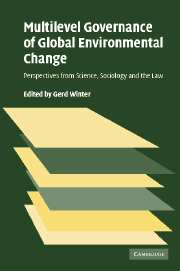 Multilevel Governance of Global Environmental Change
Multilevel Governance of Global Environmental Change Book contents
- Frontmatter
- PREFACE
- Contents
- List of figures
- List of tables
- Notes on contributors
- List of abbreviations
- 1 Introduction
- PART I Earth system analysis
- PART II Society and institutions of global; environmental change
- PART III Self-regulation of industry and the law
- 6 Private authority, global governance, and the law
- 7 Responsibility of transnational corporations in international environmental law: three perspectives
- 8 Transboundary corporate responsibility in environmental matters: fragments and foundations for a future framework
- PART IV The potential of the state
- PART V The potential of world regions
- PART VI Formation and implementation of international regimes
- PART VII Improving the instruments of global governance
- PART VIII Fundamental concepts of institutionalising common concern
- Index
8 - Transboundary corporate responsibility in environmental matters: fragments and foundations for a future framework
Published online by Cambridge University Press: 04 May 2010
- Frontmatter
- PREFACE
- Contents
- List of figures
- List of tables
- Notes on contributors
- List of abbreviations
- 1 Introduction
- PART I Earth system analysis
- PART II Society and institutions of global; environmental change
- PART III Self-regulation of industry and the law
- 6 Private authority, global governance, and the law
- 7 Responsibility of transnational corporations in international environmental law: three perspectives
- 8 Transboundary corporate responsibility in environmental matters: fragments and foundations for a future framework
- PART IV The potential of the state
- PART V The potential of world regions
- PART VI Formation and implementation of international regimes
- PART VII Improving the instruments of global governance
- PART VIII Fundamental concepts of institutionalising common concern
- Index
Summary
Transboundary subjectivity rather than effects
Corporations, just like pollution, are becoming increasingly transboundary, and they spread in increasingly complex structures. Economists and sociologists debate whether corporations, for the most part, operate as multinational enterprises (MNEs) with some national base, as transnational corporations (TNCs) active in many countries but without a particular link to any country, or through even more diffused international networks or clusters of firms, subunits, suppliers, and subcontractors. There is no general agreement on how to label the various forms of transboundary economic organisation, and neither does the given distinction reveal the diversity of corporate structures. Rather, the difficulty in terming and defining them reflects the multitude of structures and relationships.
A significant factor when allocating responsibility for environmentally harmful activities is whether one corporate unit is wholly or partly owned or controlled by another, or formally a unit within a well-defined enterprise. Yet, new corporate relations and modes of economic organisation may influence the legal conceptions of responsibility and corporate governance, so as also to make a corporate entity responsible for the conduct of another entity that is formally autonomous but actually dependent on the former.
It is a truism that corporations – whether active in one, two, or more countries – cause harm to health and the environment, and that the adverse effects may extend beyond the borders of the state of the activity.
- Type
- Chapter
- Information
- Multilevel Governance of Global Environmental ChangePerspectives from Science, Sociology and the Law, pp. 200 - 224Publisher: Cambridge University PressPrint publication year: 2006
- 1
- Cited by


